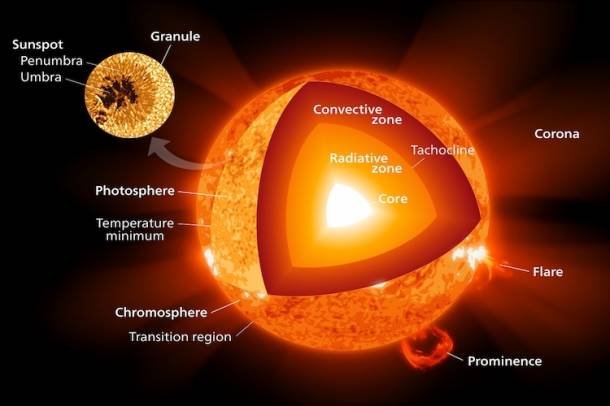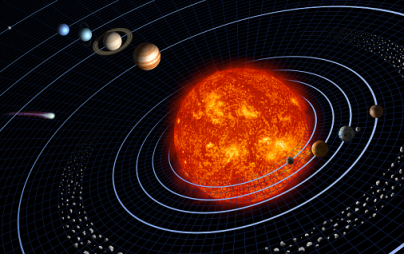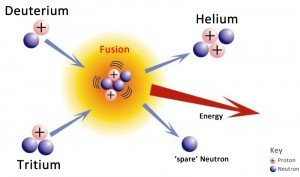Who does not know the sun? There seems to be no human dtiplanet that never knows and sees the sun. Because throughout human life is very dependent on the heat energy generated by the sun. That's why no man does not know the sun. However, do you know from which solar energy radiates energy?
The sun is the center of the solar system that is almost round and consists of hot plasma mixed with magnetic field. The diameter is about 1,392,684 km. 109 times the diameter of the earth and its mass, or about 2 × 10 30 </ sub> kilograms, 330,000 times the mass of the Earth. Representing approximately 99.86 total masses of Solar system.
Chemically, about three-quarters of the solar mass is made up of hydrogen, while the remainder is dominated by helium. The rest of the mass (1.69% or equivalent to 5,629 times the mass of the earth) consists of heavy elements of oxygen, carbon, iron, neon, and so forth.
How does the sun take place?
The sun is formed from clouds of dust and gas. The gas particles on the outer edge of it, or the nebula. Starting to fall centered and the gravity of these particles together attract more atoms. For 10 years the length of the gas cloud increases, then something happens at its core. Because of the gravitational pull, the enlarged pressure forces the nucleus to blend in the nuclear fusion process and release enormous energy. And when the fire is on, the sun has become a star.
Approximately five billion years ago, dust and gas meet from the gravitational movement of the universe. So as to make all the particles merge into one growing unity with a certain size of heat. After that the core of the sun emits light. Or in this case is called the young sun. For several million years after that, the sun continues to absorb the dust, cosmic, and surrounding gas clouds. So that the sun continues to grow to the size and all the time.
The theory of the formation of the sun is called the theory of nuclear combustion and the process of supernova theory. This theory applies not only to the process of formation of the sun alone. But this theory applies to the process of formation of other stars of Yanga and experienced by the universe.
Where did the solar energy come from?
The sun produces its energy by a nuclear fusion process found in the sun's core. Nuclear fusion is the incorporation of atomic nuclei to form heavier nuclei. Examples such as those that occur in the core of the sun. Namely the incorporation of hydrogen nuclei (H) into helium nucleus (He) or can be called alpha particles.
The nucleus of the atom consists only of one Proton, meaning that the proton-the proton goes around the core of the sun. While electrons detached proton darin. Because it is caused by the temperature of the sun's core is too high to support the existence of magnetic binding between the nucleus and the electron. How can Proton join? While protons refuse each other?
It can be overcome with pressure. Because the temperature at the core of the sun is so high it causes the pressure on the sun's core is also high. The pressure of the solar core is approximately 250 billion times pressure. The Earth's ocean surface forces Proton to move at a very high speed and can not avoid collisions and eventually the two heat elements join.
How to make a helium core, from two Protons and two neutrons?
When colliding, one of the Protons emits a positron or electron antiparticle, and neutrinos to become neutrons. This process is resumed with Proton and neutron collisions, thus becoming a helium nucleus. The collisions produce energy emerging from within Protons and neutrons. As we know that, 90% of Proton mass is 85% mass of neutrons. The rest is the mass of quarks.
The energy produced by each Proton 2 reaction is 4.2 x 10-12 joules. However, every second occurs 9.2 x 1037 reaction. So that every second the sun produces energy equivalent to 100 billion hydrogen bombs. so the conclusion is that the energy emitted by the sun comes from the collisions of the two masses. []



Awesome! I would also like to add that the sun has not only high temperature but also immense gravitational forces that induce the process of fusion.
yes, very right, thanks for the extra argument
a great post for natural science
Thanks
Great explanation!
Thanks my friend